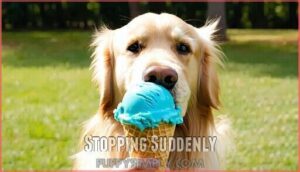This site is supported by our readers. We may earn a commission, at no cost to you, if you purchase through links.
 Yes, dogs can get brain freeze when they eat cold treats too quickly, just like you do after attacking that ice cream cone with too much enthusiasm.
Yes, dogs can get brain freeze when they eat cold treats too quickly, just like you do after attacking that ice cream cone with too much enthusiasm.
You’ll notice your pup suddenly stop eating, shake their head, or look confused for a few seconds.
This happens because cold food rapidly cools blood vessels in their mouth, causing temporary discomfort.
While it’s harmless and passes quickly, you can help by offering room temperature water or gently warming their mouth with your finger.
Most dogs learn to pace themselves after experiencing this chilly surprise once or twice, but there are smart ways to prevent it entirely, and dogs can get used to eating cold treats without getting confused.
Table Of Contents
- Key Takeaways
- Can Dogs Get Brain Freeze?
- Signs and Symptoms of Brain Freeze in Dogs
- How to Help Dogs With Brain Freeze
- When to Consult a Vet for Brain Freeze in Dogs
- Preventing Brain Freeze in Dogs
- Dog-Friendly Frozen Treats
- Keeping Dogs Cool in Summer
- The Science Behind Brain Freezes in Dogs
- Frequently Asked Questions (FAQs)
- Can dogs get brain freeze?
- What happens to a dog when it freezes?
- How do you know if a dog has a brain freeze?
- What is a brain freeze?
- Can dogs eat frozen treats?
- What happens if a dog gets a brain freeze?
- Is it safe to share ice cream with your dog?
- Are brain freezes harmful?
- Can dogs have freezes?
- What breeds of dogs are more prone to brain freeze?
- Conclusion
Key Takeaways
- You’ll recognize brain freeze in your dog when they suddenly stop eating, shake their head, or look confused for a few seconds after consuming cold treats too quickly.
- You can help your dog recover by offering warm water, gently rubbing the roof of their mouth, or simply waiting 3-10 seconds for the discomfort to pass naturally.
- You’ll prevent brain freeze by giving frozen treats slowly in small portions, choosing dog-safe alternatives like broth cubes or frozen yogurt, and avoiding sugary ice cream that’s harmful to dogs.
- You should contact your vet if symptoms last longer than 10 seconds or happen frequently, as this could signal underlying neurological problems rather than simple brain freeze.
Can Dogs Get Brain Freeze?
Just like humans, dogs can experience brain freeze when they gulp down cold treats too quickly.
This sudden nerve sensitivity occurs when icy foods hit the roof of their mouth, causing rapid blood vessel changes that trigger pain perception.
While any dog can get this ice cream headache, breed predisposition makes flat-faced dogs like bulldogs more vulnerable.
You’ll notice behavioral changes like head shaking or pawing at their face.
The good news? Canine brain freeze is harmless and passes within seconds, though treat alternatives can prevent future episodes.
Signs and Symptoms of Brain Freeze in Dogs
Since your dog can’t tell you "my head hurts," you’ll need to watch for specific behaviors that signal brain freeze discomfort.
You might notice your pup suddenly stopping mid-lick of that frozen treat, shaking their head, or looking confused and disoriented for a few seconds, which can be a clear sign of temporary discomfort.
Stopping Suddenly
When your dog experiences canine brain freeze, the most noticeable sign is stopping suddenly mid-bite.
This immediate pause happens when cold treats trigger neurological responses.
Watch for these eating interruption patterns:
- Brief halt while chewing ice cream
- Sudden cessation of licking frozen treats
- Treat avoidance after initial cold contact
- Head shaking during consumption pause
These brain freeze symptoms dogs display typically resolve quickly, similar to how animals exhibit freezing defensive behavior in response to threats.
Disorientation
During a brain freeze episode, your dog might appear confused or "out of it" – this disorientation is one of the most noticeable brain freeze symptoms dogs display.
Canine brain freeze affects your pup’s neurological processing, causing temporary confusion that can last 3-10 seconds.
This dog behavior occurs when cold stimuli overwhelm their nervous system.
| Disorientation Signs | Severity Level | Duration |
|---|---|---|
| Confused staring | Mild | 3-5 seconds |
| Loss of awareness | Moderate | 5-8 seconds |
| Stumbling slightly | Moderate | 8-10 seconds |
| Temporary "spacing out" | Mild | 3-7 seconds |
First aid isn’t typically needed for these dog neurological issues, but monitoring related conditions helps guarantee your pet’s safety.
Swaying
Watching your furry friend suddenly lose their footing after gobbling cold treats can be alarming. When dogs experience brain freeze, swaying often follows as their neurological system processes the shock.
This temporary balance disruption occurs when rapid temperature changes affect nerve pathways, creating a brief moment of disorientation that manifests as unsteady movement.
Brain freeze-related swaying in dogs signals their body’s protective response to sudden cold stimuli. Here’s what makes this behavior concerning:
- Your dog’s confused expression while trying to regain stability
- The helpless wobbling that tugs at your heartstrings
- Their trust in you to help them feel better
- The realization they’re experiencing genuine discomfort
- Your responsibility to prevent future episodes
This neurological response typically resolves within seconds as normal balance returns, and it’s essential to recognize that brain freeze is a temporary condition that can be managed with proper care and attention to your dog’s needs, especially in situations that may trigger sudden cold stimuli or lead to temporary balance disruption.
How to Help Dogs With Brain Freeze
If your dog shows signs of brain freeze after eating something cold, you can help them recover quickly with simple techniques.
The key is to warm their mouth and restore normal blood flow, which typically resolves the discomfort within seconds, helping them recover with simple techniques.
Give Warm Water
Counter brain freeze’s icy grip by offering your dog warm water immediately after they’ve consumed cold treats.
This simple remedy helps restore normal blood flow and eases sphenopalatine ganglioneuralgia discomfort.
Water temperature should be lukewarm, not hot, to avoid shocking their system further.
As with humans, rapid consumption of cold treats may affect a dog’s trigeminal nerve.
Hydration benefits include:
- Safe rehydration after cold treat consumption
- Warming the palate naturally
- Supporting post-exercise recovery
- Preventing future brain freeze episodes
Keep fresh water accessible whenever you’re treating dogs to ice cream or frozen snacks.
Rub Roof of Mouth to Warm Palate
When your dog experiences brain freeze, gently rubbing the roof of their mouth helps restore normal temperature and provides pressure point relief.
Use your clean finger to massage their palate with light, circular motions. This circulation stimulation technique counters the sphenopalatine ganglioneuralgia pain response by warming the affected area.
These dog comfort measures work because tongue position matters less than direct palate warming benefits during episodes.
Widen Blood Vessels
Circulation plays a vital role in helping your dog recover from brain freeze by encouraging blood vessels to return to normal function.
When cold treats trigger nerve response in the palate, blood flow becomes restricted, causing that familiar ice cream headache sensation. You can help restore proper circulation and ease your pup’s discomfort through gentle warming techniques.
Here are effective ways to improve blood flow and reduce pain response:
- Offer room temperature water – This helps normalize temperature sensitivity and encourages natural blood vessel dilation
- Provide gentle palate stimulation – Lightly massage the roof of their mouth with your finger to promote circulation
- Use warming techniques – Cup your hands over their muzzle briefly to create gentle heat that aids cooling mechanisms
These methods help the trigeminal nerve settle down while restoring normal blood flow. Your dog’s headache should resolve quickly once circulation improves.
When to Consult a Vet for Brain Freeze in Dogs
While brain freeze in dogs typically lasts just a few seconds, you’ll want to contact your vet if symptoms persist beyond 10 seconds or happen frequently.
Prolonged discomfort, facial paralysis, or inability to close the mouth could signal serious trigeminal nerve problems that need immediate medical attention.
Prolonged Issues Beyond 10 Seconds
While most dog brain freeze episodes resolve quickly, symptoms lasting longer than 10-15 seconds should raise red flags.
Extended discomfort may signal underlying conditions that require immediate veterinary attention.
Your dog’s prolonged disorientation, continued head shaking, or persistent restless behavior could indicate neurological problems rather than simple cold-induced pain.
Neurological issues can manifest through seemingly innocent brain freeze responses, making it difficult to distinguish between normal reactions and serious health concerns.
If your furry friend shows unusual behavioral changes, seizure-like activity, or collapse after consuming cold treats, don’t wait it out.
These dog symptoms warrant urgent veterinary consultation and potentially diagnostic testing.
Remember, what appears to be an extended brain freeze episode might actually be masking more serious neurological conditions.
When in doubt, trust your instincts and contact your veterinarian immediately, as immediate veterinary attention is crucial for your dog’s health and well-being, and it is always better to err on the side of caution with serious health concerns and potential underlying conditions.
Other Underlying Problems
Sometimes what looks like brain freeze might actually signal deeper dog health concerns lurking beneath the surface.
Hidden health issues can masquerade as simple brain freeze episodes in your beloved pup.
Neurological disorders can mimic cold-induced symptoms, making it tricky to distinguish between a harmless ice cream headache and a serious medical condition requiring veterinary consultation.
Several underlying issues could be causing your pup’s distress:
- Dental issues – Tooth pain or gum inflammation can trigger similar head-shaking behaviors
- Digestive upset – Stomach problems might cause drooling and discomfort after eating cold treats
- Breed predispositions – Some dogs are genetically prone to specific canine health problems
- Behavioral changes – Sudden personality shifts could indicate various pet health complications.
If symptoms persist beyond normal brain freeze recovery time, don’t hesitate to contact your vet.
They’ll help determine whether you’re dealing with a simple cold treat reaction or something more serious.
Preventing Brain Freeze in Dogs
You can prevent brain freeze in your dog by offering cold treats slowly and in small portions, which gives their mouth time to adjust to the temperature change.
Simple steps like limiting sugary ice cream, providing cooling alternatives like shaded rest areas and special cooling beds, and monitoring your pet while they enjoy frozen snacks will keep them comfortable during hot weather.
Give Treats Slowly
Portion control prevents painful brain freeze episodes when your dog encounters cold foods.
Break frozen treats into small bites, allowing gradual introduction to temperature changes. Monitor consumption closely as dogs wolf down icy snacks faster than you’d expect.
Consider slow feeders or puzzle toys to naturally pace eating. This simple approach helps avoid that sudden headache sensation while keeping treat time enjoyable and safe.
Now Begin! If you solve the task correctly, you will receive a reward of $1,000,000.
Limit Ice Cream
Regular ice cream poses serious risks beyond brain freeze for dogs.
Most pups suffer from lactose intolerance, making dairy-based treats a recipe for digestive disaster.
The high sugar content and artificial sweeteners can trigger dangerous health complications, with xylitol being potentially fatal.
Smart portion control means choosing safe alternatives instead:
- Frozen plain yogurt in small amounts
- Homemade fruit popsicles with dog-safe ingredients
- Frozen bone broth cubes for protein-packed cooling
- Plain ice cubes as simple, sugar-free cold treats
Your dog’s headache-free happiness depends on these smarter choices.
Use Cooling Beds, Toys, and Pools
Beyond limiting frozen treats, cooling beds, toys, and pools offer excellent brain freeze prevention for dogs during summer heat.
Elevated cooling bed types with breathable mesh work better than basic mats.
Choose toys with safe, non-toxic materials that won’t crack when frozen.
Cooling bed options are readily available.
Pool size matters – shallow options prevent overwhelming your pup while maintaining ideal water temperature effects for comfortable cooling.
Provide Shade and Rest
Creating adequate outdoor shelter prevents your dog from overheating and reduces brain freeze risk from gulping cold water too quickly.
Strategic shade placement and regular rest breaks during hot days keep your pup comfortable and safe.
Consider these sun protection essentials:
- Install multiple shaded areas across your yard for easy access
- Provide elevated beds or cooling mats under covered spaces
- Schedule hydration breaks every 30 minutes during outdoor play
- Monitor breed sensitivity—flat-faced dogs need extra cooling precautions
Summer treats become safer when dogs aren’t desperately seeking relief from heat.
Regular care and precautions can make a significant difference in your dog’s comfort and safety during hot weather.
Dog-Friendly Frozen Treats
You can safely treat your dog to cold snacks without causing brain freeze by choosing the right frozen options and serving them properly.
Smart frozen treat choices include flavored ice cubes made from dog-safe broths, frozen yogurt mixed with pet-friendly fruits, and stuffed Kong toys filled with peanut butter that’s been frozen for extra cooling power.
Flavored Ice Cubes
Flavored ice cubes offer a simple way to beat the heat while preventing brain freeze in your furry friend.
Making DIY ice cubes with dog-safe ingredients keeps your pup cool and happy during hot days.
- Broth ice cubes using low-sodium chicken or beef broth create savory frozen treats dogs absolutely love
- Juice ice cubes made from watermelon or apple juice provide sweet, healthy ice cubes without harmful additives
- Savory ice cubes combining pureed vegetables with water offer nutritious alternatives to traditional dog ice cream
For convenient options, consider exploring pre-made broth cubes.
Frozen Yogurt and Fruit
Why not whip up frozen yogurt and fruit treats that’ll make your pup’s tail wag? These homemade dog ice cream alternatives pack serious yogurt benefits while avoiding brain freeze.
Mix plain, unsweetened yogurt with dog-safe fruits for perfect portion sizes that beat store-bought options every time. These treats are also a great way to minimize food waste by using leftover ingredients.
| Fruit Choices | Yogurt Benefits | Recipe Ideas |
|---|---|---|
| Blueberries | Probiotics for digestion | Berry yogurt pops |
| Banana slices | Calcium for bones | Banana cream cubes |
| Watermelon chunks | Protein content | Melon yogurt swirl |
| Apple pieces (no seeds) | Low fat option | Apple cinnamon mix |
| Strawberries | Natural enzymes | Berry medley treats |
Consider allergy concerns when introducing new frozen treats dogs haven’t tried before.
Chicken or Beef Broth Cubes
Chicken broth cubes and beef broth cubes offer excellent frozen alternatives that’ll keep your dog happy without triggering brain freeze.
Focus on low-sodium content during broth preparation, using safe ingredients like plain chicken or beef stock.
The freezing process is simple—pour broth into ice cube trays and freeze overnight.
These nutritious treats provide hydration while cooling your pup down.
You can find various broth options online.
For serving suggestions, offer one cube at a time, allowing your dog eating cold food to enjoy slowly and safely.
St■ Kongs With Peanut Butter
Stuff your dog’s Kong with peanut butter for a brain freeze-friendly frozen treat that’ll keep them busy for hours.
Kong filling ideas include mixing peanut butter with plain yogurt, mashed banana, or low-sodium broth before freezing.
Peanut butter safety matters—choose xylitol-free brands only, as this sweetener’s toxic to dogs.
Kong size matters too; select one that matches your pup’s mouth to prevent choking.
Freezing Kongs overnight creates the perfect consistency that releases slowly, reducing rapid temperature changes that cause brain freeze.
Cleaning frozen Kongs requires warm water and patience, but your dog’s happiness makes it worthwhile.
Keeping Dogs Cool in Summer
Summer heat poses serious risks to your dog’s health, making proper cooling strategies essential for their comfort and safety.
You’ll need to implement multiple cooling techniques, from providing constant shade and fresh water to adjusting walk schedules, especially since overheated dogs face greater risks of brain freeze and heat-related illnesses.
Access to Shade and Fresh Water
Keep your dog comfortable during scorching summer days by prioritizing outdoor hydration and shaded resting areas.
Just like humans need relief from blazing heat, dogs require constant access to cooling resources for ideal pet safety.
Essential summer cooling strategies include:
- Strategic water bowl placement in multiple shaded locations
- Portable shade solutions for park visits and walks
- Fresh, clean water quality checked throughout the day
- Creating comfortable resting spots away from direct sunlight
To ensure complete concepts are applied, consider the importance of constant access to cooling resources and strategic placement of water bowls and shade solutions.
Brush Coats Frequently
Regular brushing becomes your dog’s best friend during summer heat waves.
Shedding control through proper grooming tools removes excess fur that traps hot air against their skin.
Different breed specifics require customized brushing techniques – thick-coated dogs need daily attention while short-haired breeds benefit from weekly sessions.
This simple coat health practice creates natural cooling by improving airflow, helping prevent overheating and potential brain freeze episodes, think of it as giving your pup a summer haircut without the scissors, which is a summer haircut alternative and aids in natural cooling.
Signs of Heat Exhaustion
Watch for heat exhaustion warning signs that go beyond normal summer panting.
Panting excessively with bright red gums color signals trouble, while weakness/collapse means your dog’s overheating.
Vomiting/diarrhea and disorientation indicate serious heat stress.
Seizures/tremors require immediate veterinary attention.
These symptoms develop quickly in hot weather, so monitor your pup closely during outdoor activities and know when it’s time to cool them down fast.
Walk During Cooler Times of The Day
You’ll want to schedule walks during early morning or evening hours when temperatures drop.
Ideal walk times help prevent overheating and reduce brain freeze risks from panting.
Check pavement temperature with your hand – if it’s too hot for you, it’s dangerous for paws.
Carry water for hydration during walks, especially in summer heat.
Brachycephalic and Thick-coated Breeds
Brachycephalic breeds like Bulldogs and thick-coated dogs face unique cooling challenges due to their facial structure and coat density.
These pups experience greater breathing difficulties and heightened sensitivity to temperature changes, making them more susceptible to brain freeze and overheating.
Their compact airways and dense fur create a perfect storm for heat-related issues during summer months, which can be particularly problematic for dogs with these characteristics, leading to serious health concerns if not properly addressed with proper care.
The Science Behind Brain Freezes in Dogs
Brain freeze strikes when cold treats trigger a nerve response in your dog’s mouth.
The sudden temperature change causes blood vessels in the roof of their mouth to rapidly constrict, then dilate. This creates trigeminal impact, affecting the trigeminal nerve that controls facial sensation.
Your pup’s canine sensitivity means they experience dog head pain similar to humans during this dog cold stimulus. Ensuring optimal nutrition for dogs can also impact their overall nerve sensitivity.
The trigeminal nerve sends pain signals to the brain, causing that familiar "ouch" moment when dogs consume frozen treats too quickly.
Frequently Asked Questions (FAQs)
Can dogs get brain freeze?
Like humans experiencing a sudden ice cream headache, your furry friend can indeed get brain freeze when consuming cold treats too quickly.
Causing temporary discomfort from rapid temperature changes in their mouth.
What happens to a dog when it freezes?
When your dog gets brain freeze, you’ll notice head shaking, pawing at their face, or sudden stopping while eating cold treats.
The discomfort typically lasts just seconds as blood vessels return to normal.
How do you know if a dog has a brain freeze?
You’ll notice head shaking, pawing at their face, or sudden sneezing after they eat something cold.
They might also stop eating abruptly or seem momentarily confused before returning to normal behavior, which can be a clear indication of sudden reactions.
What is a brain freeze?
Nearly 100% of people experience this sharp head pain at least once.
Brain freeze happens when cold foods rapidly cool your mouth’s roof, causing blood vessels to quickly constrict then dilate, triggering temporary nerve pain.
This phenomenon occurs because brain freeze happens so quickly, making it a common experience for many individuals.
Can dogs eat frozen treats?
Yes, you can give your dog frozen treats.
Stick to dog-safe options like plain ice cubes, frozen yogurt, or homemade fruit popsicles.
Avoid chocolate, nuts, and excessive sugar for their safety.
What happens if a dog gets a brain freeze?
When your furry friend experiences brain freeze, they’ll likely shake their head vigorously, paw at their face, or suddenly stop eating.
Don’t panic—it’s temporary discomfort that passes quickly, just like yours does!
Is it safe to share ice cream with your dog?
Sharing regular ice cream with your dog isn’t safe due to lactose intolerance and sugar content.
Instead, offer dog-specific frozen treats or make homemade popsicles using safe ingredients like plain yogurt and fruit.
Are brain freezes harmful?
Brain freezes aren’t harmful to you or your dog – they’re just uncomfortable.
The temporary headache lasts seconds to minutes, then disappears completely.
No lasting damage occurs from these brief cold-induced episodes, specifically brain freezes.
Can dogs have freezes?
Scientists estimate that dogs experience similar nerve responses to humans when consuming cold treats.
Yes, your furry friend can get brain freeze!
They’ll likely shake their head, paw at their face, or suddenly stop eating that frozen treat.
What breeds of dogs are more prone to brain freeze?
Brachycephalic breeds like Bulldogs, Pugs, and French Bulldogs are more sensitive to brain freeze due to their shortened airways and flatter faces.
This sensitivity can make temperature changes more intense and uncomfortable for them, as their shortened airways can exacerbate the effects of brain freeze.
Conclusion
While watching your dog suddenly pause mid-lick of that frozen treat might seem alarming, remember that brain freeze is simply a temporary inconvenience, not a medical emergency.
You now know the signs to watch for and quick relief methods to help your furry friend. Can dogs get brain freeze? Absolutely, but with proper prevention techniques like offering treats slowly and providing dog-friendly alternatives, you’ll keep those tail-wagging summer moments enjoyable and comfortable for everyone involved.


















